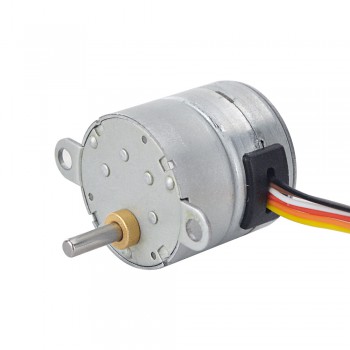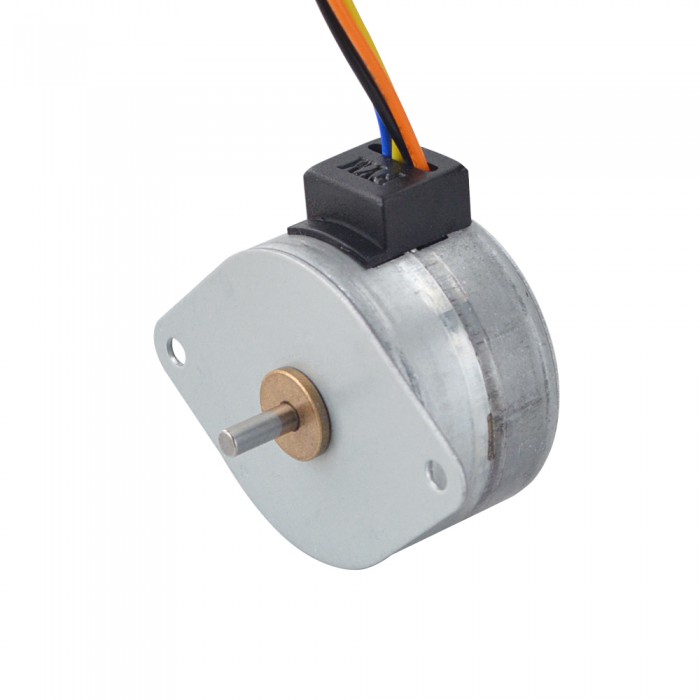1.What is a permanent magnet stepper motor
The permanent magnet stepper motor is an electromechanical energy conversion device that converts electrical energy into mechanical energy. The working principle of this motor is based on the interaction between the rotor and stator magnetic fields, and the rotation is generated by the interaction between the magnetic rotor core and the pulsed electromagnetic field generated by the stator. The interaction between the rotor magnetic field and the stator magnetic field of the permanent magnet stepper motor generates torque, thereby realizing the conversion of electrical energy. The motor rotor of the permanent magnet stepper motor usually uses rare earth permanent magnet tiles, which are processed into claw-type tooth poles by stamping dies, and the motor rotor uses axial multi-pole magnetized rare earth permanent magnet tiles. This design makes the cost of the motor relatively low.
2.Requirements for the design of permanent magnet stepper motors
1.Technical parameter setting: The design of permanent magnet stepper motors first needs to clarify their technical parameters, such as peak torque, maximum speed, efficiency, etc. For example, in the motor bench test, the maximum efficiency of motor and feed is 93%, the peak torque is 165N.m, and the maximum speed reaches 14000rpm. In addition, the design requirements also stipulate that the torque pulsation does not exceed 5% and the maximum efficiency is not less than 93%.
2.Material selection: In terms of material selection, the performance and cost of the motor need to be considered. For example, the stator and rotor punchings use M330-35A-60C silicon steel sheets with a thickness of 0.35mm. This material has good magnetic conductivity and low loss characteristics, which helps to improve the efficiency of the motor and reduce the temperature rise.
3.Design principles: Some basic principles need to be followed in the design process, such as the selection of slot-pole matching, rotor skew, single-layer wiring, spiral water cooling, etc. These principles are intended to reduce the vibration and noise of the motor and improve the performance and reliability of the motor.
4.Design process: The design process includes simulation using Ansoft software, electromagnetic verification using MotorCad, verification of the force of the motor rotor under low-speed high torque and high-speed centrifugal force using Workbench, and decomposition of the electromagnetic excitation force of the motor using Matlab. These processes ensure the accuracy and reliability of the motor design.
3.Technical difficulties that permanent magnet stepper motors need to overcome
1.Stability of magnetic steel: The rotor magnetic steel of permanent magnet motors is usually fixed by two methods: embedded or attached to the outer surface of the rotor through adhesive materials. However, under the centrifugal force generated by the high-speed rotation of the rotor, both of these fixing methods have the risk of the magnetic steel falling off and being thrown out, especially when the magnetic steel loses magnetism, this problem is more serious. This limits the realization of high speed of the motor and may cause other operating hazards such as increased motor vibration. In order to solve this problem, the use of carbon fiber composite materials to fix the magnetic steel has become an ideal solution, because it can effectively ensure the safe and stable operation of the rotor under high-speed conditions.
2.Anti-magnetization technology: Improving anti-magnetization technology is one of the technical challenges faced by permanent magnet motors. The anti-magnetization ability of the motor can be improved by adding load detection, lowering the maximum load, increasing heat dissipation measures, and avoiding frequent starting. For example, the BMW i3 monitors the internal temperature of the motor by setting a temperature upper limit in the operating mode, setting a temperature sensor in the stator winding, and estimating the rotor temperature through a thermal model to avoid problems caused by excessive temperature.
3.High-temperature demagnetization problem: Permanent magnet motors are prone to demagnetization in high-temperature environments, which can cause motor performance degradation or even damage. The real-time and precise wireless temperature controller for large permanent magnet motors with dual-channel temperature and electricity developed by Zhejiang Mechanical and Electrical Vocational and Technical College has broken through the technical pain points of the permanent magnet motor industry by reducing the economic losses of enterprises caused by high-temperature demagnetization. The realization of this technology not only improves the safety of the motor, but also achieves import substitution, which has important economic and social significance.

4.Application fields of permanent magnet stepper motors
1.In computer peripheral equipment, photography systems, viewpoint combination devices, valve control and other fields, permanent magnet stepper motors are used to achieve precise position control and motion control to meet the high requirements of accuracy and reliability in these fields.
2.In CNC machine tools and automatic winding machines, permanent magnet stepper motors provide high-precision and reliable solutions to ensure the accuracy and efficiency of work.
3.In the field of medical equipment, such as CT scanners, X-ray machines, etc., permanent magnet stepper motors are used to achieve precise control of rotating mechanisms to meet the special needs of medical imaging equipment.
4.In the fields of electronic clocks, automatic embroidery machines, etc., permanent magnet stepper motors are used to achieve precise time display and precise positioning of embroidery patterns.
5.In the office automation and home appliance industries, permanent magnet stepper motors are used to achieve precise control and movement of equipment to improve work efficiency and user experience.
6.In automation equipment and electronic equipment, such as industrial robots, printers, scanners, etc., permanent magnet stepper motors provide high-precision and reliable motion control, ensuring stable operation and high-quality output of the equipment.
7.In the textile industry, permanent magnet stepper motors are widely used in spinning machines, looms and other equipment to improve production efficiency and quality.
